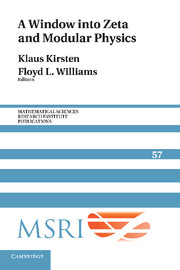Book contents
- Frontmatter
- Contents
- Introduction
- Lectures on zeta functions, L-functions and modular forms with some physical applications
- Basic zeta functions and some applications in physics
- Zeta functions and chaos
- Vertex operators and modular forms
- Applications of elliptic and theta functions to Friedmann–Robertson–Lemaître–Walker cosmology with cosmological constant
- Integrable systems and 2D gravitation: How a soliton illuminates a black hole
- Functional determinants in higher dimensions using contour integrals
- The role of the Patterson–Selberg zeta function of a hyperbolic cylinder in three-dimensional gravity with a negative cosmological constant
The role of the Patterson–Selberg zeta function of a hyperbolic cylinder in three-dimensional gravity with a negative cosmological constant
Published online by Cambridge University Press: 29 May 2025
- Frontmatter
- Contents
- Introduction
- Lectures on zeta functions, L-functions and modular forms with some physical applications
- Basic zeta functions and some applications in physics
- Zeta functions and chaos
- Vertex operators and modular forms
- Applications of elliptic and theta functions to Friedmann–Robertson–Lemaître–Walker cosmology with cosmological constant
- Integrable systems and 2D gravitation: How a soliton illuminates a black hole
- Functional determinants in higher dimensions using contour integrals
- The role of the Patterson–Selberg zeta function of a hyperbolic cylinder in three-dimensional gravity with a negative cosmological constant
Summary
1. Introduction
A few years ago, the author took note of certain sums that appeared in the physics literature in connection with thermodynamic of the BTZ black hole—a three-dimensional solution discovered by M. Ba˜nados, C. Teitelboim, and J. Zanelli [1] of the Einstein gravitational field equations
with negative cosmological constant. Here Rij = Rij(g), R = R(g) are the Ricci tensor and Ricci scalar curvature, respectively, of the solution metric [g = gij]. We describe the BTZ metric in equation (2.1) below. These sums were used to express, for example, the nondivergent part of the effective BTZ action, or corrections to classical Bekenstein–Hawking entropy [4; 13; 15]—sums that physicists evidently did not realize were related to the Patterson–Selberg zeta function of a hyperbolic cylinder. The paper [21], for example, was written to point out this relation and thus to establish a thermodynamics-zeta function connection. Another such connection appears in my Lecture 6 of this volume.
In [23; 25; 26], for example, we see that the Mann–Solodukhin quantum correction to black hole entropy [15] is expressed, in fact, in terms of a suitable “deformation” of. It is also possible to keep track of a corresponding deformation of the black hole topology. We review the deformation of zeta, and of the BTZ topology, in Section 4 below where we use it to set up a one-loop determinant formula (or an effective action formula) in the presence of conical singularities.
In Section 3 we express the one-loop quantum field partition function, the one-loop gravity partition function , and the full gravity partition function all in terms of the zeta function. Using the holomorphic sector of the oneloop gravity partition function and the classical elliptic modular function one can build up (with the help of Hecke operators) modular invariant partition functions of proposed holomorphic conformal field theories with central charge 24k, where k is a positive integer—theories first defined by G. Höhn [12] and proposed by E. Witten [28] as the holographic dual of pure 2+1 gravity.
Information
- Type
- Chapter
- Information
- A Window into Zeta and Modular Physics , pp. 329 - 351Publisher: Cambridge University PressPrint publication year: 2010
